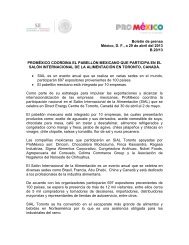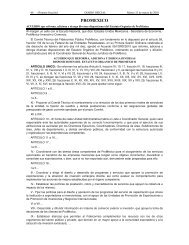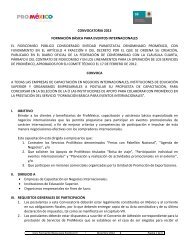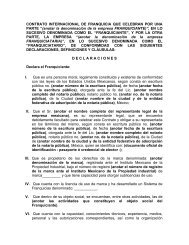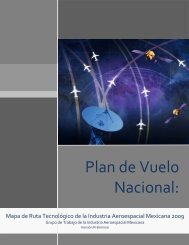MINING IN MEXICO S - ProMéxico
MINING IN MEXICO S - ProMéxico
MINING IN MEXICO S - ProMéxico
You also want an ePaper? Increase the reach of your titles
YUMPU automatically turns print PDFs into web optimized ePapers that Google loves.
16 Negocios i The Lifestyle<br />
illustration oldemar<br />
Mining: A Strategic Sector For<br />
Mexico And The World<br />
By MARÍA CRIST<strong>IN</strong>A ROSAS *<br />
Mining is a strategic sector for the Mexican economy and is one of the<br />
country’s assets when it comes to attracting foreign direct investment.<br />
Despite the international financial crisis, in 2009 Mexico remained as one of<br />
the most attractive and safe destinations for mining companies worldwide,<br />
reason why investors are taking increasing interest on Mexican mines.<br />
Current economic dynamics would be<br />
hard to understand without mining. Although<br />
some insist that modern economies<br />
derive a large proportion of their<br />
revenue and prosperity from the service<br />
sector, primary sector activities form the<br />
economy’s real bedrock. Without exaggerating,<br />
the World Bank confirms that the<br />
most significant progress toward satisfying<br />
human needs –including food, accommodation,<br />
health, education, employment<br />
and transport– relies on the increasingly<br />
efficient use of mineral resources. Furthermore,<br />
some studies suggest that activities<br />
such as manufacturing, construction<br />
and even agriculture, could not exist<br />
without mineral production.<br />
Mining plays a leading social-economic<br />
role in Mexico. At its various stages –from<br />
exploration to production– it generates a<br />
significant number of jobs and income for<br />
the country. In 2009, it accounted for 3.6%<br />
of Mexico’s GDP (mining expanded), 4% of<br />
Mexican exports and 270,000 direct jobs.<br />
Due to the rising demand for minerals<br />
by the world’s largest and most rapidlygrowing<br />
economies, mining is becoming<br />
increasingly important. China, for example,<br />
has increased its mineral consumption<br />
to support its dizzying economic<br />
growth, contributing to the growth in global<br />
prices for various minerals. African and<br />
Latin American countries are among its<br />
providers. The African continent is seen<br />
as a gigantic deposit of mineral resources –<br />
with everything from oil to coltan– and the<br />
world’s largest economies are ever more interested<br />
in that part of the world. But when<br />
it comes to mining, Mexico has a number of<br />
advantages, even over African countries.<br />
Mexico offers a solid and less risky alternative<br />
for mining production. Several African<br />
countries suffer from armed conflict, endemic<br />
diseases, poor infrastructure and lack<br />
of governmental transparency, which exponentially<br />
increases the operating costs for<br />
foreign investment despite the abundance of<br />
mineral resources.<br />
Mexico possesses significant mineral deposits<br />
that are widely sought after around<br />
the world. The country is among the twelve<br />
largest producers of 17 minerals. It is the<br />
world’s second largest producer of silver, bismuth<br />
and fluorite; the third of celestite; the<br />
fourth of wollastonite and diatomite; the fifth<br />
of lead; the sixth of cadmium and molybdenum;<br />
the seventh of zinc, salt and graphite;<br />
the eighth of manganese and baryte and the<br />
twelfth of feldspar, gold and copper.<br />
Investors are taking increasing interest<br />
in Mexican mines given their reserves of<br />
strategic minerals, some of which are key to<br />
industries such as aerospace, military and<br />
electronics.<br />
This all explains how, despite the international<br />
financial crisis, Mexico remained one<br />
of the world’s top investment destinations<br />
in 2009. In terms of mining exploration, it<br />
ranked as the top investment destination in<br />
Latin America and fourth in the world.<br />
Mexican legislation encourages investments<br />
in the sector. The 1993 Mining Law<br />
(Ley Minera) replaced the 1961 legislation<br />
and opened up new areas to foreign investment<br />
previously limited to Mexican financing.<br />
It also removed the requirement for foreign<br />
capital investments to be associated with<br />
Mexican capital in a proportion of 49-51 per<br />
cent respectively. The Foreign Investment<br />
Law further liberalized the mining industry<br />
in a process consolidated by NAFTA and the<br />
removal of several investment requirements<br />
–for production work only to use Mexican<br />
supplies, for training and technology transfer<br />
or for nationality requirements imposed on<br />
the majority of members sitting on boards of<br />
directors– as well as tariff reduction on foreign<br />
trade and the import of equipment and<br />
machinery. That opened up unprecedented<br />
opportunities for private foreign investors<br />
interested in the mining sector. The new legislation<br />
heralded another important change:<br />
the duration of concessions, which are<br />
awarded for 50 years and may be extended.<br />
The Mexican mining sector is a highly<br />
attractive investment. It is far quicker for<br />
a company to obtain an operating license<br />
in Mexico than in other countries. The US<br />
company Hecla referred to the “comparative<br />
advantages” offered by Mexico in relation<br />
to its other commercial partners, confirming<br />
that it had taken only eight months to be<br />
granted the license concession for the project<br />
at La Choya in Sonora. In the US or Canada<br />
the process would have taken between five



